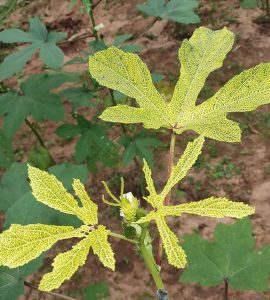Bhendi (Abelmoschus esculentus), also known as okra or lady’s finger, is a popular vegetable that is widely grown and consumed in India. Like any other crop, bhendi is also susceptible to various diseases like fusarium wilt, powdery mildew, leaf spot and yellow vein mosaic virus. that can affect its growth and yield. Among these, yellow vein mosaic or vein-clearing is the most devasting viral disease in all bhendi growing regions of India. If the crop is affected by the virus at early stages, up to 80% of crop loss can be expected.
Yellow Vein Mosaic in Bhendi
The virus can infect plants at any growth stage. The infections are more prevalent during the summer months when the incidence and infestation of whiteflies are more severe.
Causal organism: Bhendi Yellow Vein Mosaic Virus
Vector: Whitefly (Bemisia tabaci)
Symptoms of Yellow Vein Mosaic / Vein Clearing in Bhendi:

- Yellowing of veins and veinlets of the leaves.
- Later, interveinal regions of the leaves turn yellow or white.
- The leaves of the infected plant may show mosaic patterns of yellow and green.
- In case of severe infection, affected young leaves show complete chlorosis.
- The infected plants may show stunted growth and reduced size.
- The leaves may be smaller in size and may show distortion or curling.
- Affected plants may produce fewer flowers and fruits, and the fruits may be deformed, smaller in size, harder and yellow green in colour.
Preventive Measures:
There are no known treatments for yellow vein mosaic virus, once a plant is infected. However, a combination of preventive measures and control strategies can be effective in managing the disease and minimize crop loss.
- Use Yellow Vein Mosaic Virus (YVMV) tolerant varieties/hybrids of bhendi like Rudraksh F1 Roshani Okra, Urja Agri – Bhindi Marina, Sarpan F1 hybrid bhindi, Indam 9821 bhendi, Pan 2127 hybrid bhendi.
- Avoid growing susceptible varieties during summer, since whitefly activity is high during the season.
- Remove and destroy the disease affected plants from the field to avoid secondary spread.
- Keep the field clean and free from weeds.
- Control the population of whiteflies and prevent the spread of the virus.
- Introduce natural predators of whiteflies, such as ladybugs and lacewings, to control their populations.
- Avoid excessive use of ammoniacal nitrogen fertilizers as it can increase the susceptibility of plants to viral infections.
- Plant leguminous crops like beans or lentils in rotation with bhendi to improve soil health and reduce the risk of disease transmission.
- Plant marigold, maize or sunflower as border crops to trap the vector, whitefly.
- Spray chilli and garlic extracts to repel whiteflies.
- Give foliar spray of Magnum Mn and Geo life No Virus to enhance the plant’s resistance to YVMV and reduce the incidence of the disease.
- Crop rotation with non-host crops.
- Installation of yellow sticky traps @ 6-8 per acre.
Control Measures for Vector, Whitefly:
| Product Name | Technical Content | Dosage |
| Mechanical Management | ||
| Tapas Yellow Sticky Trap | Sticky trap | 4 – 6 per acre |
| Biological Management | ||
| Greenpeace Neemol Bio Neem oil | Neem Oil extracts (Azardiractin) | 1 – 2 ml/lit of water |
| Anand Dr Bacto’s Brave | Beauveria bassiana | 2.5 ml/lit of water |
| Chemical Management | ||
| Anant Insecticide | Thiamethoxam 25% WG | 0.3 – 0.5 gm/lit of water |
| Benevia Insecticide | Cyantraniliprole 10.26% OD | 1.7 – 2 ml/lit of water |
| Dhanpreet Insecticide | Acetamiprid 20% SP | 0.2 – 0.4 gm/lit of water |
| Tatamida SL Insecticide | Imidacloprid 17.8% SL | 1 – 2 ml/lit of water |
| Police Insecticide | Fipronil 40% + Imidacloprid 40% WG | 0.2 – 0.6 gm/lit of water |
| Osheen Insecticide | Dinotefuran 20 % SG | 0.3 – 0.4 gm/lit of water |
| Movento Energy Insecticide | Spirotetramat 11.01% + Imidacloprid 11.01% SC | 0.5 – 1 ml/lit of water |
Discover more about diseases and insect-pests affecting okra: symptoms and control measures. CLICK HERE





